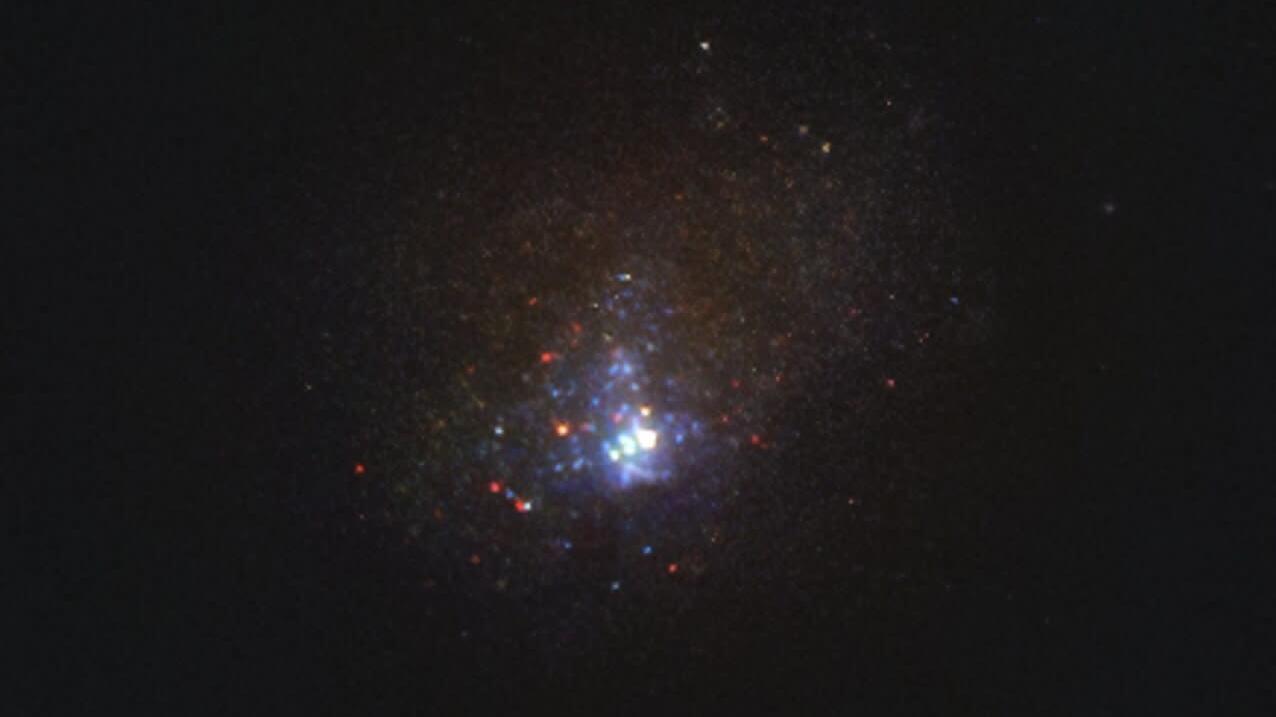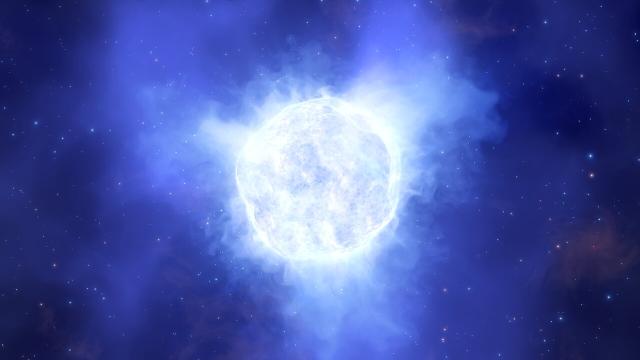An unusually bright star in a nearby galaxy has gone missing, in a mystery of cosmic proportions.
An object inside the Kinman dwarf galaxy has disappeared from view, according to new research published today in Monthly Notices of the Royal Astronomical Society. This massive and exceptionally bright blue star was hypothesised to exist based on astronomical observations made between 2001 and 2011, but as of 2019, it is no longer detectable.
The authors of the study, led by PhD student Andrew Allan of Trinity College Dublin, have conjured two possible explanations: Either the star has experienced a dramatic drop in luminosity and is now partially hiding behind some dust, or it transformed into a black hole without sparking a supernova explosion. If it’s the latter, it would represent just the second known failed supernova.
The Kinman dwarf galaxy is located 75 million light-years from Earth, so it’s not close by any means. Astronomers cannot discern individual stars owing to the tremendous distances involved, but the hypothesised star in question is a luminous blue variable (LBV), which is detectable at extreme distances. LBVs are massive and unpredictable stars at the end of their lives. The variable nature of this star, through its dramatic shifts in spectra and brightness, can be spotted from Earth. Incredibly, this suspected star is 2.5 times brighter than our Sun.
Or at least it was.

Observations gathered from 2001 to 2011 pointed to a late-stage LBV in the Kinman dwarf galaxy. In 2019, a team of astronomers wanted to take another look to see how it was doing, and they did so using the European Southern Observatory’s Very Large Telescope. To their surprise, there was nothing to see ” a result that was both exciting and discouraging at the same time.
“We were all pleasantly surprised to find that the star’s signature was not present in our first observation taken in August 2019 using the ESPRESSO instrument of ESO’S Very Large Telescope,” Allan told Gizmodo. “We initially hoped for a higher-resolution observation that resembled the past observations, which we would use for our models.”
Figuring there was something wonky with ESPRESSO, Allan and his colleagues decided to take another look with the telescope’s X-shooter instrument.
“We rechecked the ESPRESSO observation a number of times but were unable to detect the star’s signature,” said Allan. “As the conditions were not perfect on the day this observation was made, we wanted to make sure the signature was truly absent. This time we used the X-Shooter instrument of the Very Large Telescope and were happy to find that this also pointed towards the star disappearing.”
With nothing new to see, and with a mystery that suddenly needed to be solved, the team dove into the archives, looking at previous observations of the dwarf galaxy. As it turns out, the suspected massive star experienced a strong outburst period that came to end around 2011. LBVs are known to throw the odd temper tantrum, resulting in a sudden loss of mass and a sharp increase in brightness.
In the wake of this particular outburst period, it’s possible that “we are seeing the end of an LBV eruption of a surviving star, with a mild drop in luminosity, a shift to hotter effective temperatures, and some dust obscuration,” wrote the authors in the study. So the star might still be active, it’s just now too dim for us to detect from Earth.
Another possible explanation is that the star collapsed into a massive black hole without an accompanying supernova explosion ” what astronomers call a failed supernova.
“This would be consistent with some of the current computer simulations that predict that some stars will not produce a bright supernova when they die,” Allan told Gizmodo. “This happens when a massive black hole is formed, and it is not spinning very fast. However a collapse to a black hole without producing a supernova has only been observed once in the past, in the galaxy of NGC 6946 where a smaller massive star seemed to disappear without a bright supernova explosion.”
If a supernova-less transition into a black hole is the case, it would mark the first known example of this happening to a massive star in a low metallicity galaxy, a finding that “could hold important clues as to how stars could collapse to a black hole without producing a bright supernova,” said Allan.
“It’s a very interesting finding that is reported in the paper, with a very careful and well done analysis,” Beatriz Villarroel, a postdoc at IAC Tenerife and the Nordic Institute for Theoretical Physics, told Gizmodo. “LBVs are unstable stars, and the analysis presented by the authors certainly contributes to the understanding of these quizzical objects. In this particular case, it’s likely that they’ve observed the end of a strong eruption with a surviving star,” said Villarroel, who wasn’t involved in the new study.
As a relevant aside, the new paper is not to be confused with a similar paper co-authored by Villarroel from last year. Instead of tracking the disappearance of LBVs, Villarroel and her colleagues tracked a phenomenon known as red transients, in which dim red dots get brighter and then recede from view.
Imre Bartos, a physicist at the University of Florida, said we have lots to learn about massive stars and how they die, given their rarity and short lifetimes.
“The current consensus is that stars cannot end their lives as black holes heavier than about 65 times the mass of the Sun,” Bartos, who wasn’t involved in the new study, told Gizmodo. “If the disappearance of the star is indeed due to its collapse to a heavier black hole, we will have to rethink our understanding of how stars live and die.”
To which he added: “At this point, there are still uncertainties about this result and it is important to study this observation further, so additional observations and a thorough search for similar disappearances are critical.”
To support the failed supernova hypothesis, Villarroel said, “we need to look for objects that stay missing for decades.” And given the “very short time scales involved in the observations in the current paper, it makes me think we’re going see more [activity] from that star again,” she told Gizmodo.
That’s an exciting possibility, requiring astronomers to train their telescopes toward the Kinman dwarf galaxy. This mystery is far from being solved, but if Villarroel is correct, there’s still potential for this star, if it still exists, to shine brightly once again.
